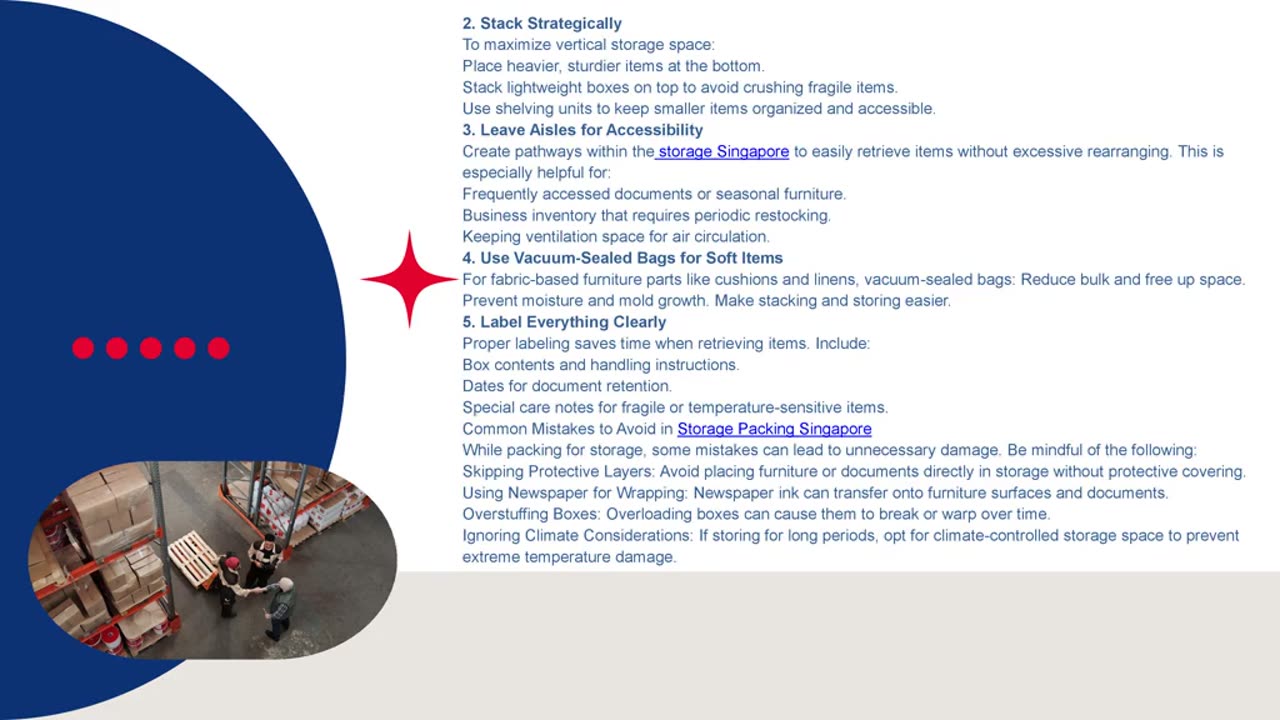Premium Only Content

Best Packing Materials for Safe Storage in Singapore — Storkship
When it comes to storing valuable furniture and important documents, using the right packing materials is essential. Whether you’re placing items in short-term or long-term storage, protecting them from dust, moisture, pests, and physical damage should be a top priority. A well-planned packing strategy ensures that your belongings remain in pristine condition, regardless of the duration of storage. This article explores the various packing materials available, their effectiveness in safeguarding furniture and documents, and best practices for maximizing storage space in Singapore.
Why Proper Packing Matters
Storage facilities provide a secure environment for furniture and documents, but without the correct packing materials, items can be susceptible to damage. Common threats include:
Moisture and Humidity: Can cause mold, mildew, and warping of wood furniture and paper documents.
Pests: Rodents and insects can chew through packaging and damage the contents.
Physical Damage: Scratches, dents, and tears can occur if items are not adequately protected.
Dust and Dirt: Can accumulate over time, leading to deterioration of delicate materials.
Temperature Fluctuations: Extreme temperatures can cause wooden furniture to crack and documents to become brittle.
Using high-quality packing materials mitigates these risks, ensuring the longevity and preservation of stored items.
Essential Packing Materials for Furniture Storage
Furniture, whether made of wood, metal, or upholstery, requires careful handling before being placed in storage. Below are the best packing materials to use:
1.Moving Blankets and Furniture Pads
Moving blankets provide a thick, cushioned layer that protects furniture from scratches and dents. These are ideal for:
Wooden tables, chairs, and cabinets.
Upholstered sofas and mattresses.
Metal furniture to prevent rust formation.
2. Plastic Wrap (Stretch Film)
Plastic wrap is essential for sealing furniture items and protecting them from dust and moisture. It works well for:
Sofas and chairs to keep upholstery clean.
Wooden furniture to prevent minor scratches.
Bundling smaller parts of disassembled furniture.
3. Bubble Wrap
For fragile or delicate furniture parts, bubble wrap provides an additional layer of protection. Use it for:
Glass tabletops and mirrors.
Decorative wooden carvings.
Handles and knobs that might break during transit.
4. Corrugated Cardboard Sheets
Cardboard sheets act as barriers against impacts and abrasions. They are useful for:
Placing between furniture pieces to prevent direct contact.
Wrapping around sharp edges.
Lining storage space floors to prevent moisture absorption.
5. Furniture Covers
Custom furniture covers are available for:
Sofas and armchairs to keep dust and pests away.
Mattresses to prevent moisture damage.
Wooden tables to prevent surface scratches.
Packing Materials for Document Storage
Documents, whether business records, personal files, or valuable archives, require specialized protection. Paper is highly susceptible to environmental damage, making the right packing approach crucial.
1.Acid-Free Archival Boxes
Unlike standard cardboard boxes, acid-free archival boxes prevent yellowing and deterioration. Use them for:
Important legal and financial records.
Historical documents.
Photographs and certificates.
2. Waterproof Plastic Containers
For maximum protection against water damage, opt for airtight plastic containers. These are ideal for:
Long-term document storage.
Sensitive files requiring extra protection.
Storing in humid environments.
3. File Folders and Dividers
To maintain organization and prevent paper curling, use:
Hanging file folders for quick access.
Dividers to separate different document types.
Labeling systems to easily identify contents.
4. Silica Gel Packets
Moisture-absorbing silica gel packets help control humidity levels inside storage boxes. Place them:
Inside document storage containers.
Within filing cabinets.
Alongside books and paper files.
5. Laminated Pouches
For extremely valuable documents, laminating provides an extra protective barrier. Use them for:
Birth certificates and passports.
Contracts and legal paperwork.
Rare or sentimental letters.
Maximizing Storage Space with Proper Packing
Packing efficiently not only protects your items but also ensures that you make the best use of your available storage Singapore. Follow these guidelines to optimize your storage unit:
1.Disassemble Large Furniture
Taking apart bulky furniture helps save space and prevents damage. Store furniture parts separately, ensuring:
Screws and small hardware are packed in labeled zip-lock bags.
Table legs and bed frames are wrapped in protective material.
Larger parts are stacked upright against walls for stability.
2. Stack Strategically
To maximize vertical storage space:
Place heavier, sturdier items at the bottom.
Stack lightweight boxes on top to avoid crushing fragile items.
Use shelving units to keep smaller items organized and accessible.
3. Leave Aisles for Accessibility
Create pathways within the storage Singapore to easily retrieve items without excessive rearranging. This is especially helpful for:
Frequently accessed documents or seasonal furniture.
Business inventory that requires periodic restocking.
Keeping ventilation space for air circulation.
4. Use Vacuum-Sealed Bags for Soft Items
For fabric-based furniture parts like cushions and linens, vacuum-sealed bags: Reduce bulk and free up space. Prevent moisture and mold growth. Make stacking and storing easier.
5. Label Everything Clearly
Proper labeling saves time when retrieving items. Include:
Box contents and handling instructions.
Dates for document retention.
Special care notes for fragile or temperature-sensitive items.
Common Mistakes to Avoid in Storage Packing Singapore
While packing for storage, some mistakes can lead to unnecessary damage. Be mindful of the following:
Skipping Protective Layers: Avoid placing furniture or documents directly in storage without protective covering.
Using Newspaper for Wrapping: Newspaper ink can transfer onto furniture surfaces and documents.
Overstuffing Boxes: Overloading boxes can cause them to break or warp over time.
Ignoring Climate Considerations: If storing for long periods, opt for climate-controlled storage space to prevent extreme temperature damage.
Not Checking on Stored Items Regularly: Periodically inspect storage units Singapore for signs of damage, pests, or humidity issues.
Packing materials play a crucial role in preserving furniture and documents in storage. From moisture-resistant plastic wraps to acid-free document boxes, selecting the right materials enhances protection and extends the lifespan of stored items. Additionally, efficient packing strategies help maximize storage Singapore, keeping units well-organized and accessible.
Whether you’re storing valuable business records, sentimental personal documents, or high end furniture, investing in the right packing solutions ensures peace of mind. A well prepared storage approach prevents unnecessary damage and maintains your belongings in pristine condition, ready for future use.
Visit our site :https://storkship.sg/
-
 34:27
34:27
The Connect: With Johnny Mitchell
19 hours ago $14.90 earnedCan He Stop Them? Inside Trumps War On Mexican Drug Cartels & The New Era Of Mexican Organized Crime
41.3K23 -
 2:33:15
2:33:15
Tundra Tactical
11 hours ago $14.28 earnedLuis Valdes Of GOA Joins The Worlds Okayest Firearms Live Stream!!!
46.8K1 -
 1:03:41
1:03:41
Man in America
20 hours agoAre Trump & Musk the COUNTER-ELITES? w/ Derrick Broze
105K93 -
 3:45:08
3:45:08
DLDAfterDark
11 hours ago $12.91 earnedDLD Live! SHTF Handguns! Which Would You Choose?
57.3K4 -
 1:50:38
1:50:38
Mally_Mouse
13 hours agoSaturday Shenanigans!! - Let's Play: Mario Party Jamboree
65.9K -
 1:13:00
1:13:00
Patriots With Grit
17 hours agoWill Americans Rise Up? | Jeff Calhoun
54.9K14 -
 14:55
14:55
Exploring With Nug
17 hours ago $12.79 earnedWe Found Semi Truck Containers While Searching for Missing Man!
75K16 -
 27:57
27:57
MYLUNCHBREAK CHANNEL PAGE
1 day agoOff Limits to the Public - Pt 3
164K73 -
 38:07
38:07
Michael Franzese
18 hours agoLeaving Organized Crime and Uncovering Mob in Politics: Tudor Dixon and Michael Franzese
124K15 -
 2:42:54
2:42:54
Jewels Jones Live ®
2 days agoAMERICA IS BACK | A Political Rendezvous - Ep. 111
96.3K50